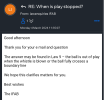Russell Jones
RefChat Addict
I'd welcome thoughts / help on the correct location for the drop ball restart in various situations. I find the wording of Law 8 a little confusing, potentially contradictory and leading to game management challenges .. but maybe it's just one too many Rum ****tails over Christmas  . Here's where I got to ......
. Here's where I got to ......
1) Red Defender clears ball from own penalty area - play is stopped for an injury with ball clearly going to Blue team --> Drop ball to Red in penalty area
2) Red Defender clears ball from own penalty area - hits outside agent in Centre Circle --> Drop ball to Red in Centre Circle
3) Red Defender clears ball from own penalty area - deflects off Blue attacker just outside area, hits outside agent in Centre Circle --> Drop ball to Blue in Centre Circle
4) Red Defender clears ball from own penalty area - deflects off Blue attacker just outside area then play is stopped for injury --> Drop ball to Blue just outside area
5) Red Defender clears ball from just outside penalty area - ball hits referee in Centre Circle and falls to Blue team --> Drop ball to Red in Centre Circle
I appreciate that some of these scenarios can be 'managed', either by judicious timing of the whistle or even by going with a safe 'what football expects' rather than pedantically applying Law. However, at this stage, I'm just trying to ensure I'm crystal clear on the strict Law approach
 . Here's where I got to ......
. Here's where I got to ......1) Red Defender clears ball from own penalty area - play is stopped for an injury with ball clearly going to Blue team --> Drop ball to Red in penalty area
2) Red Defender clears ball from own penalty area - hits outside agent in Centre Circle --> Drop ball to Red in Centre Circle
3) Red Defender clears ball from own penalty area - deflects off Blue attacker just outside area, hits outside agent in Centre Circle --> Drop ball to Blue in Centre Circle
4) Red Defender clears ball from own penalty area - deflects off Blue attacker just outside area then play is stopped for injury --> Drop ball to Blue just outside area
5) Red Defender clears ball from just outside penalty area - ball hits referee in Centre Circle and falls to Blue team --> Drop ball to Red in Centre Circle
I appreciate that some of these scenarios can be 'managed', either by judicious timing of the whistle or even by going with a safe 'what football expects' rather than pedantically applying Law. However, at this stage, I'm just trying to ensure I'm crystal clear on the strict Law approach




